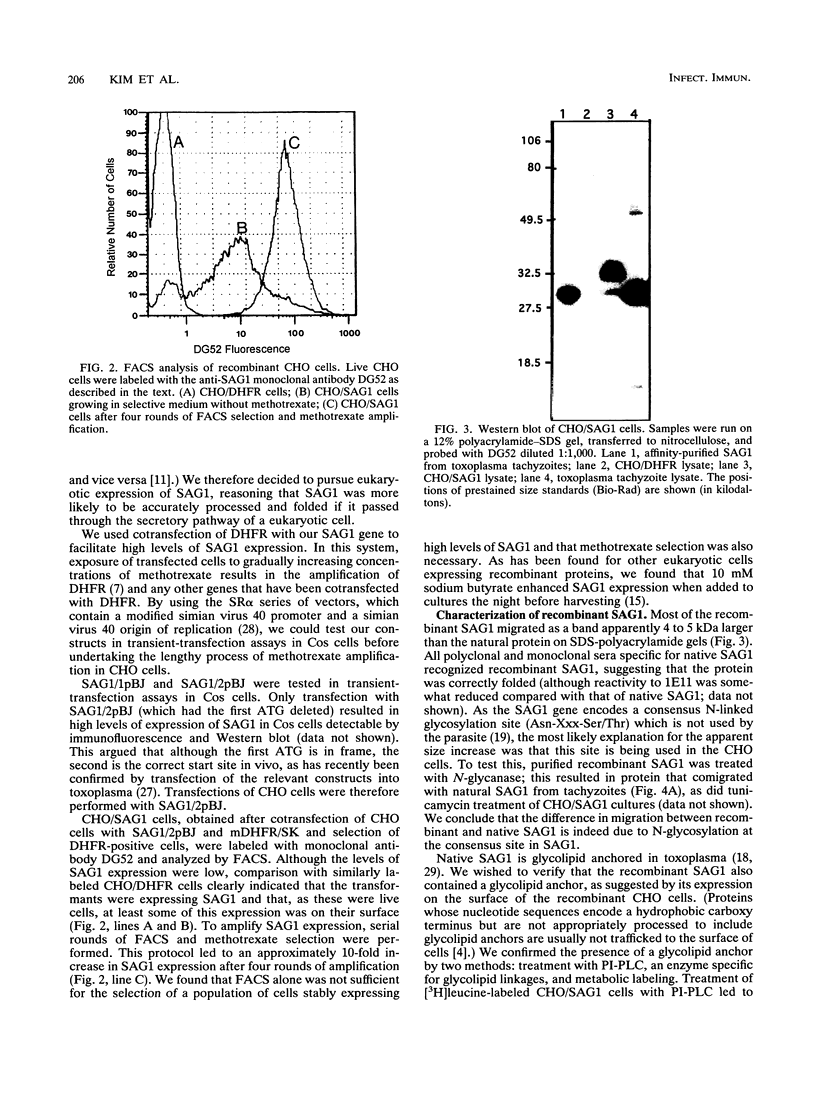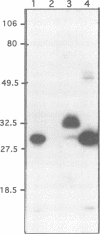Abstract
The Toxoplasma gondii major surface antigen, called SAG1 or p30, is a highly immunogenic protein which has generated great interest as a diagnostic reagent, as a potential subunit vaccine, and for its role in invasion. Unfortunately, bacterial recombinant protein is grossly misfolded so that, for example, it is not effectively recognized by antibodies to native SAG1. To overcome this, we have turned to expression in CHO cells, using cotransfection of the SAG1 gene and the mouse dihydrofolate reductase (DHFR) gene into CHO cells that are DHFR-. SAG1 expression was amplified by methotrexate coselection of CHO cells in combination with fluorescence-activated cell sorting for SAG1 expression. The resulting population expressed recombinant SAG1 that is recognized by antiserum specific for natural, nonreduced SAG1, indicating that, unlike in bacteria, expression in CHO cells results in proper folding. Processing was at least partially correct in that, like natural SAG1, recombinant SAG1 was attached to the plasma membrane via a glycolipid anchor, although tunicamycin treatment was necessary to prevent N-glycosylation (SAG1 is not glycosylated in the parasite but does have a consensus N-linked site). Finally, purified recombinant SAG1 was recognized by human sera known to be reactive to toxoplasma proteins, indicating that this material has potential as a diagnostic reagent and possibly as a component of a subunit vaccine.
Full text
PDF






Images in this article
Selected References
These references are in PubMed. This may not be the complete list of references from this article.
- Brändli A. W. Mammalian glycosylation mutants as tools for the analysis and reconstitution of protein transport. Biochem J. 1991 May 15;276(Pt 1):1–12. doi: 10.1042/bj2760001. [DOI] [PMC free article] [PubMed] [Google Scholar]
- Burg J. L., Perelman D., Kasper L. H., Ware P. L., Boothroyd J. C. Molecular analysis of the gene encoding the major surface antigen of Toxoplasma gondii. J Immunol. 1988 Nov 15;141(10):3584–3591. [PubMed] [Google Scholar]
- Bülow R., Boothroyd J. C. Protection of mice from fatal Toxoplasma gondii infection by immunization with p30 antigen in liposomes. J Immunol. 1991 Nov 15;147(10):3496–3500. [PubMed] [Google Scholar]
- Cross G. A. Glycolipid anchoring of plasma membrane proteins. Annu Rev Cell Biol. 1990;6:1–39. doi: 10.1146/annurev.cb.06.110190.000245. [DOI] [PubMed] [Google Scholar]
- Dannemann B., McCutchan J. A., Israelski D., Antoniskis D., Leport C., Luft B., Nussbaum J., Clumeck N., Morlat P., Chiu J. Treatment of toxoplasmic encephalitis in patients with AIDS. A randomized trial comparing pyrimethamine plus clindamycin to pyrimethamine plus sulfadiazine. The California Collaborative Treatment Group. Ann Intern Med. 1992 Jan 1;116(1):33–43. doi: 10.7326/0003-4819-116-1-33. [DOI] [PubMed] [Google Scholar]
- Decoster A., Darcy F., Caron A., Capron A. IgA antibodies against P30 as markers of congenital and acute toxoplasmosis. Lancet. 1988 Nov 12;2(8620):1104–1107. doi: 10.1016/s0140-6736(88)90523-5. [DOI] [PubMed] [Google Scholar]
- Gasser C. S., Simonsen C. C., Schilling J. W., Schimke R. T. Expression of abbreviated mouse dihydrofolate reductase genes in cultured hamster cells. Proc Natl Acad Sci U S A. 1982 Nov;79(21):6522–6526. doi: 10.1073/pnas.79.21.6522. [DOI] [PMC free article] [PubMed] [Google Scholar]
- Grimwood J., Smith J. E. Toxoplasma gondii: the role of a 30-kDa surface protein in host cell invasion. Exp Parasitol. 1992 Feb;74(1):106–111. doi: 10.1016/0014-4894(92)90144-y. [DOI] [PubMed] [Google Scholar]
- Gross U., Roos T., Appoldt D., Heesemann J. Improved serological diagnosis of Toxoplasma gondii infection by detection of immunoglobulin A (IgA) and IgM antibodies against P30 by using the immunoblot technique. J Clin Microbiol. 1992 Jun;30(6):1436–1441. doi: 10.1128/jcm.30.6.1436-1441.1992. [DOI] [PMC free article] [PubMed] [Google Scholar]
- Huskinson J., Stepick-Biek P. N., Araujo F. G., Thulliez P., Suzuki Y., Remington J. S. Toxoplasma antigens recognized by immunoglobulin G subclasses during acute and chronic infection. J Clin Microbiol. 1989 Sep;27(9):2031–2038. doi: 10.1128/jcm.27.9.2031-2038.1989. [DOI] [PMC free article] [PubMed] [Google Scholar]
- Huskinson J., Thulliez P., Remington J. S. Toxoplasma antigens recognized by human immunoglobulin A antibodies. J Clin Microbiol. 1990 Dec;28(12):2632–2636. doi: 10.1128/jcm.28.12.2632-2636.1990. [DOI] [PMC free article] [PubMed] [Google Scholar]
- Johnson A. M., McDonald P. J., Neoh S. H. Monoclonal antibodies to Toxoplasma cell membrane surface antigens protect mice from toxoplasmosis. J Protozool. 1983 May;30(2):351–356. doi: 10.1111/j.1550-7408.1983.tb02929.x. [DOI] [PubMed] [Google Scholar]
- Kasper L. H., Khan I. A., Ely K. H., Buelow R., Boothroyd J. C. Antigen-specific (p30) mouse CD8+ T cells are cytotoxic against Toxoplasma gondii-infected peritoneal macrophages. J Immunol. 1992 Mar 1;148(5):1493–1498. [PubMed] [Google Scholar]
- Khan I. A., Ely K. H., Kasper L. H. A purified parasite antigen (p30) mediates CD8+ T cell immunity against fatal Toxoplasma gondii infection in mice. J Immunol. 1991 Nov 15;147(10):3501–3506. [PubMed] [Google Scholar]
- Lisanti M. P., Field M. C., Caras I. W., Menon A. K., Rodriguez-Boulan E. Mannosamine, a novel inhibitor of glycosylphosphatidylinositol incorporation into proteins. EMBO J. 1991 Aug;10(8):1969–1977. doi: 10.1002/j.1460-2075.1991.tb07726.x. [DOI] [PMC free article] [PubMed] [Google Scholar]
- McCabe R., Remington J. S. Toxoplasmosis: the time has come. N Engl J Med. 1988 Feb 4;318(5):313–315. doi: 10.1056/NEJM198802043180509. [DOI] [PubMed] [Google Scholar]
- Mineo J. R., McLeod R., Mack D., Smith J., Khan I. A., Ely K. H., Kasper L. H. Antibodies to Toxoplasma gondii major surface protein (SAG-1, P30) inhibit infection of host cells and are produced in murine intestine after peroral infection. J Immunol. 1993 May 1;150(9):3951–3964. [PubMed] [Google Scholar]
- Nagel S. D., Boothroyd J. C. The major surface antigen, P30, of Toxoplasma gondii is anchored by a glycolipid. J Biol Chem. 1989 Apr 5;264(10):5569–5574. [PubMed] [Google Scholar]
- Odenthal-Schnittler M., Tomavo S., Becker D., Dubremetz J. F., Schwarz R. T. Evidence for N-linked glycosylation in Toxoplasma gondii. Biochem J. 1993 May 1;291(Pt 3):713–721. doi: 10.1042/bj2910713. [DOI] [PMC free article] [PubMed] [Google Scholar]
- Partanen P., Turunen H. J., Paasivuo R. T., Leinikki P. O. Immunoblot analysis of Toxoplasma gondii antigens by human immunoglobulins G, M, and A antibodies at different stages of infection. J Clin Microbiol. 1984 Jul;20(1):133–135. doi: 10.1128/jcm.20.1.133-135.1984. [DOI] [PMC free article] [PubMed] [Google Scholar]
- Potasman I., Araujo F. G., Desmonts G., Remington J. S. Analysis of Toxoplasma gondii antigens recognized by human sera obtained before and after acute infection. J Infect Dis. 1986 Oct;154(4):650–657. doi: 10.1093/infdis/154.4.650. [DOI] [PubMed] [Google Scholar]
- Remington J. S., Araujo F. G., Desmonts G. Recognition of different Toxoplasma antigens by IgM and IgG antibodies in mothers and their congenitally infected newborns. J Infect Dis. 1985 Nov;152(5):1020–1024. doi: 10.1093/infdis/152.5.1020. [DOI] [PubMed] [Google Scholar]
- Santoro F., Afchain D., Pierce R., Cesbron J. Y., Ovlaque G., Capron A. Serodiagnosis of toxoplasma infection using a purified parasite protein (P30). Clin Exp Immunol. 1985 Nov;62(2):262–269. [PMC free article] [PubMed] [Google Scholar]
- Sharma S. D., Mullenax J., Araujo F. G., Erlich H. A., Remington J. S. Western Blot analysis of the antigens of Toxoplasma gondii recognized by human IgM and IgG antibodies. J Immunol. 1983 Aug;131(2):977–983. [PubMed] [Google Scholar]
- Sibley L. D., Boothroyd J. C. Construction of a molecular karyotype for Toxoplasma gondii. Mol Biochem Parasitol. 1992 Apr;51(2):291–300. doi: 10.1016/0166-6851(92)90079-y. [DOI] [PubMed] [Google Scholar]
- Sibley L. D., Boothroyd J. C. Virulent strains of Toxoplasma gondii comprise a single clonal lineage. Nature. 1992 Sep 3;359(6390):82–85. doi: 10.1038/359082a0. [DOI] [PubMed] [Google Scholar]
- Soldati D., Boothroyd J. C. Transient transfection and expression in the obligate intracellular parasite Toxoplasma gondii. Science. 1993 Apr 16;260(5106):349–352. doi: 10.1126/science.8469986. [DOI] [PubMed] [Google Scholar]
- Takebe Y., Seiki M., Fujisawa J., Hoy P., Yokota K., Arai K., Yoshida M., Arai N. SR alpha promoter: an efficient and versatile mammalian cDNA expression system composed of the simian virus 40 early promoter and the R-U5 segment of human T-cell leukemia virus type 1 long terminal repeat. Mol Cell Biol. 1988 Jan;8(1):466–472. doi: 10.1128/mcb.8.1.466. [DOI] [PMC free article] [PubMed] [Google Scholar]
- Tomavo S., Schwarz R. T., Dubremetz J. F. Evidence for glycosyl-phosphatidylinositol anchoring of Toxoplasma gondii major surface antigens. Mol Cell Biol. 1989 Oct;9(10):4576–4580. doi: 10.1128/mcb.9.10.4576. [DOI] [PMC free article] [PubMed] [Google Scholar]





